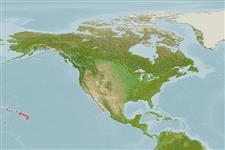Teleostei (teleosts) >
Blenniiformes (Blennies) >
Blenniidae (Combtooth blennies) > Salariinae
Etymology: Cirripectes: Latin, cirrus = curl fringe + Greek, pektos, -e, -on = made of several parts solidly united (Ref. 45335); vanderbilti: Named for M. George Vanderbilt.
Eponymy: George Washington Vanderbilt III (1914–1961) was a scientific explorer whose main interest was marine life. [...] (Ref. 128868), visit book page.
More on author: Fowler.
Issue
close to C. variolosus
Environment: milieu / climate zone / depth range / distribution range
Ecology
Marine; reef-associated; depth range 1 - 10 m (Ref. 529). Tropical; 25°N - 15°N
Eastern Central Pacific: Hawaiian and Johnston islands. Has been confused with the closely related species Cirripectes variolosus (Ref. 583).
Length at first maturity / Size / Weight / Age
Maturity: Lm ?, range 4 - ? cm
Max length : 10.0 cm SL male/unsexed; (Ref. 529)
Dorsal spines (total): 12; Dorsal soft rays (total): 13 - 15; Anal spines: 2; Anal soft rays: 15 - 16; Vertebrae: 30 - 31. Diagnosis: Dorsal fin XII, 14, membrane attached to caudal fin, with deep notch above last spine, first spine slightly higher than second; anal fin II, 15; pectoral rays 15; pelvic fin I, 4; caudal fin procurrent rays 10-12. Vertebrae 10 + 20. LL, without scales but with scalelike flaps; LL tubes 0-5, canal ends below 7th dorsal ray and caudal-fin base. Lower lip smooth mesially, plicate laterally. Upper lip crenulae 42-54. Gill rakers 23-30. Cephalic pore system complex; midsnout pores present. Cirri, supraorbital 9-22, nasal 7-23; nuchal 31-42, in 2 groups with ventralmost cirri borne on small nuchal flap. Adults with brown body; red spots or narrow lines on snout and around the eye; black iris with yellow-ringed pupil and an outer bright reddish orange ring (Ref. 529).
Body shape (shape guide): fusiform / normal; Cross section: oval.
Facultative air-breathing in the genus (Ref. 126274); Benthic in coral and rock (Ref. 58302). The most common blenny on shallow reefs. Adults feed on benthic algae and detritus (Ref. 3921). Oviparous. Eggs are demersal and adhesive (Ref. 205), and are attached to the substrate via a filamentous, adhesive pad or pedestal (Ref. 94114). Larvae are planktonic, often found in shallow, coastal waters (Ref. 94114).
Life cycle and mating behavior
Maturity | Reproduction | Spawning | Eggs | Fecundity | Larvae
Oviparous, distinct pairing (Ref. 205). Urogenital orifice of male genital papilla located basally between 2 closely appressed slender filaments on a fleshy swelling behind anus; testes bulbous with length equal its width (Ref. 529).
Williams, J.T., 1988. Revision and phylogenetic relationships of the blenniid fish genus Cirripectes. Indo-Pac. Fish. (17):78 p. (Ref. 529)
IUCN Red List Status (Ref. 130435: Version 2025-1)
Threat to humans
Harmless
Human uses
Fisheries: of no interest; aquarium: commercial
Tools
Special reports
Download XML
Internet sources
Estimates based on models
Preferred temperature (Ref.
123201): 24.8 - 25.6, mean 25.3 °C (based on 29 cells).
Phylogenetic diversity index (Ref.
82804): PD
50 = 0.5000 [Uniqueness, from 0.5 = low to 2.0 = high].
Bayesian length-weight: a=0.01047 (0.00461 - 0.02381), b=2.98 (2.79 - 3.17), in cm total length, based on LWR estimates for this (Sub)family-body shape (Ref.
93245).
Trophic level (Ref.
69278): 2.0 ±0.00 se; based on food items.
Resilience (Ref.
120179): High, minimum population doubling time less than 15 months (Preliminary K or Fecundity.).
Fishing Vulnerability (Ref.
59153): Low vulnerability (10 of 100).
🛈
Nutrients (Ref.
124155): Calcium = 136 [71, 236] mg/100g; Iron = 0.887 [0.519, 1.470] mg/100g; Protein = 18.4 [17.2, 19.4] %; Omega3 = 0.124 [0.073, 0.210] g/100g; Selenium = 19 [10, 37] μg/100g; VitaminA = 128 [36, 453] μg/100g; Zinc = 2.56 [1.72, 3.69] mg/100g (wet weight);
